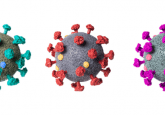Could a biosensing cloth be used to kill viruses?

A research team from Iowa State University (IA, USA) led by Sonal Padalkar have developed a novel biosensing-platform technology by growing nanostructures on a carbon cloth.
The biosensors, made of cerium oxide nanostructures, were developed to detect glucose levels in the blood as well as other vital health indicators.
In a paper published in ACS Sustainable Chemistry & Engineering Padalkar demonstrates how her biosensor, when the cerium oxide nanostructures are grown directly on a carbon cloth, exhibit extremely high sensitivity, down to a low detection limit due to a high surface area and high defect concentration on the surface of cloth.
The fabrication technique involves using electrochemical deposition whereby an electric current is applied to the cloth or paper at the same time as a solution containing precursors to the metal oxides. The research demonstrates the potential for flexible and robust substrates, whether carbon cloth or paper, combined with nanostructures for use as affordable and adaptable biosensors.
While developing this technology, Padalkar also discovered a concurrent advantage of the cerium oxide carbon cloths – they have antimicrobial properties. On studying this further the team discovered that nanomaterials puncture the cells walls of single-cell microbes, leading to their destruction. When the nanomaterials are fabricated on a cloth, it effectively becomes an intrinsically-disinfecting cloth.
“The implications of our present antimicrobial studies are enormous,” Padalkar elucidated. “We can find applications in wide areas, including our everyday life to many very specific applications, like surgical units in hospitals.”
Padalkar also explained how the technology could be used against viruses – puncturing the protein coat of the virus, killing it – a find that could prove extremely useful in the current climate.
This potential application for the nanofabricated carbon cloths needs much further research and testing before widespread use, but the possibilities for the cloths to be distributed as antimicrobial materials throughout homes, hospitals, workplaces, schools and farms are very encouraging in an age of such need.
“We do not plan to wrap up this work soon,” Padalkar affirmed. “The need for antimicrobial products is urgent and understanding the details of the mechanism and material parameters is paramount for the success of these new materials.”
For access to more free content relating to the COVID-19 outbreak, please visit our sister site, Infectious Diseases Hub here.
For more nanomedicine news, become a member of The Nanomed Zone for free here.





